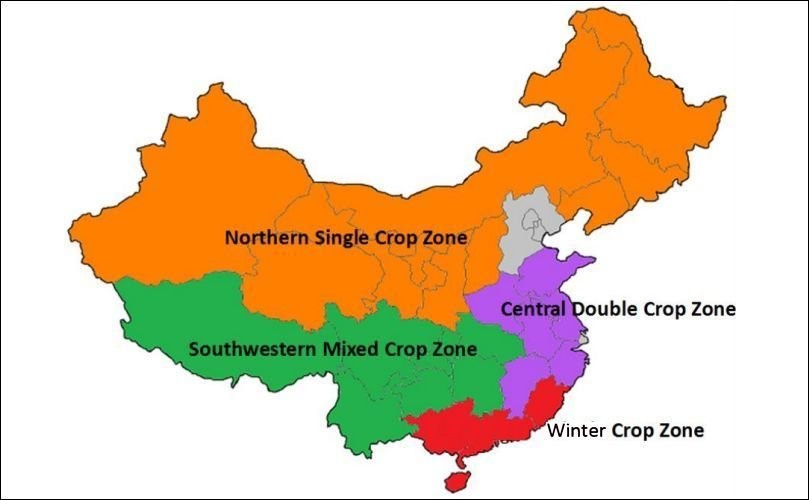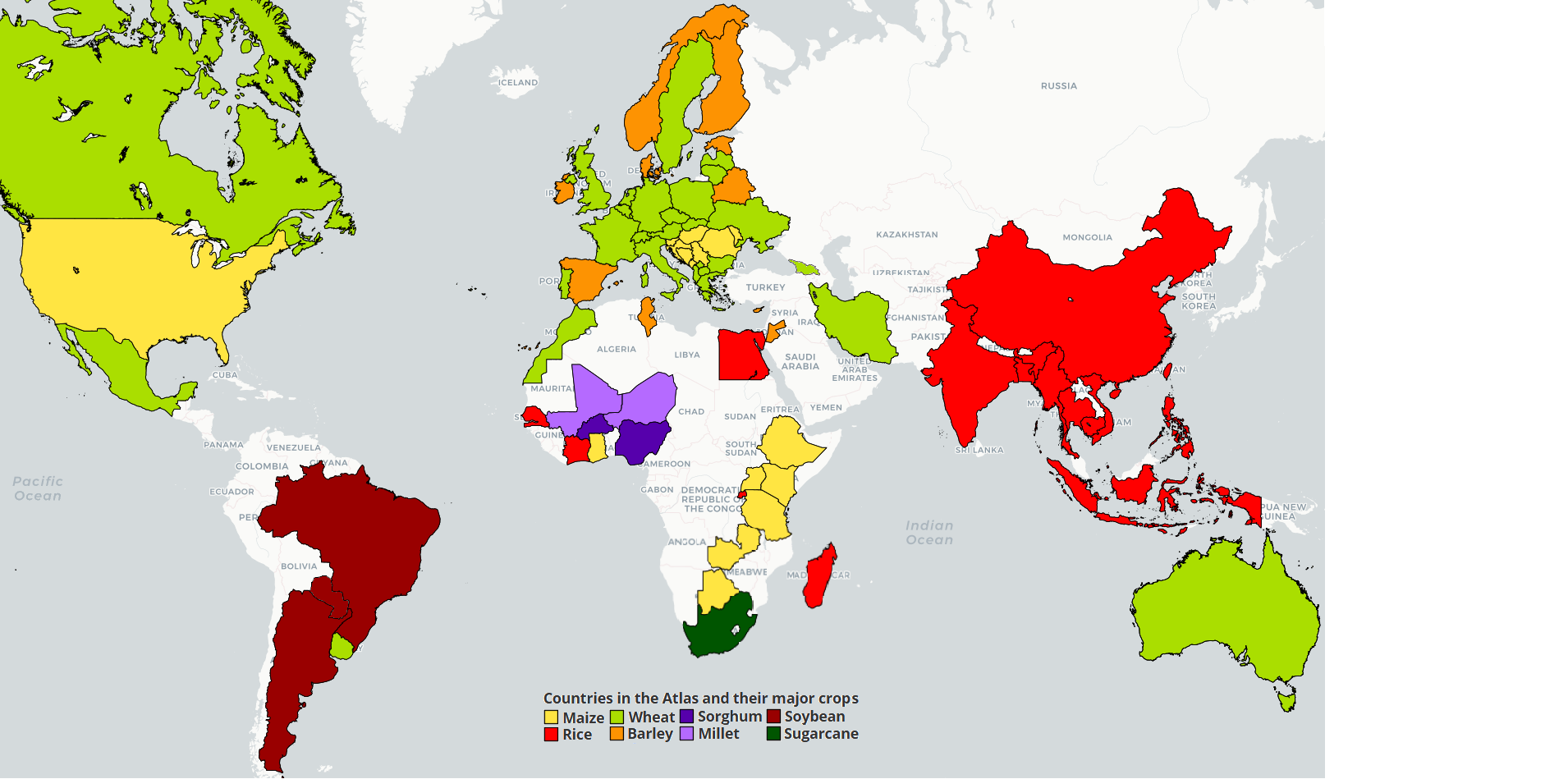 China Potato
China Potato
China is the largest potato producing country in the world in terms of area and production (FAO, 2019). The total production area of potato in China was 4.9 million ha in 2017, which was much less than the area allocated to the three staple crops (i.e., 30.7 million ha for rice; 42.4 million ha for maize; 24.5 million ha for wheat in 2017) (NBSC, http://www.stats.gov.cn/tjsj/). Potato ranks number 6 in terms of total production area in China (after maize, rice, wheat, soybean and rapeseed). Potato production occurs mainly in four agroecological zones: (Zone I) northern single crop zone (49% of total area) where one potato crop is planted annually in the summer season (including Qinghai, Gansu, Ningxia, Xinjiang, Inner Mongolia, Shanxi, Shaanxi, Hebei, Heilongjiang, Jilin and Liaoning provinces); (Zone II) southwestern mixed single and multi-crop zone (39%) where potato can be planted throughout the year (Sichuan, Chongqing, Guizhou, Yunnan, Tibet and northern part of Hubei and Hunan provinces). Potatoes are planted mainly in the mountainous regions with large variation in altitude and climate conditions, which allows one potato cultivation in higher altitude area and multiple potato crops in low-land area; (Zone III) central double crop zone (5%) where potato cultivation is feasible in spring and autumn (Jiangxi, Jiangsu, Zhejiang, Anhui, Shandong, and Henan provinces); and (Zone IV) winter crop zone (7%) where potato is cultivated in winter (Guangdong, Guangxi, Fujian, Taiwan, and Hainan provinces) (Fig. 1, 2) (MOA, 2008; USDA, 2018). Table potato is widely cultivated across the country. Coarse starch is traditionally the dominant processed product, while the area under varieties processed to flakes, French fries and crisps is quickly expanding, which is facilitated by the rapid growth of the country's economy and rising demand for diversified diets. China is enhancing potato production in both area and quantity as a strategy to safeguard domestic food self-sufficiency (MO A, 2016).

Figure 1. Four agro-ecological zones of potato production in China. Source: USDA, 2018.

Figure 2. Potato growing season in the four agro-ecological zones in China (Sources: USDA, 2018; China, World Potato Atlas, CIP-collab, https://research.cip.cgiar.org).
Harvested area
The locations and area of potato production in China (i.e., both irrigated and rainfed) were retrieved from SPAM2005 (http://mapspam.info/). Potato in China is mainly cultivated under rainfed conditions, while irrigation is sometimes supplied in the north to obtain good yield and quality potato for processing purpose. The explicit area and location of irrigated potato is unknown. Based on farmer surveys and company interviews, we learnt that many potato processing companies have been established recently in northern China, which encouraged the expansion of large-scale irrigated potato production systems. We first identified the Designated Climate Zones (DCZs) for potato in the country (see the below section). We then selected the DCZ for irrigated potato based on expert knowledge, i.e. climate zone 1-2-03, which is located mainly in Inner Mongolia (we assumed 176,000 ha irrigated area and 72,000 ha rainfed area). All other DCZs were assumed to refer to rainfed potato cultivation. We estimated yield gaps only for the dominant growing season in regions with two or more potato growing seasons, i.e. the spring season in the southwest.
Weather data and reference weather stations (RWS)
The weather data used were obtained from the China Meteorological Data Service Centre (http://data.cma.cn/en./). Solar radiation was obtained from the NASA-POWER project (http://power.larc.nasa.gov/).
Designed Climate Zones (DCZs) were selected when a zone covers more than 2.5% of total potato area in the country. According to the GYGA protocol, a DCZ is determined when it covers more than 5% of national crop area, and more than 50% of total potato area is covered by selected DCZs. However, when using these criteria, the selected DCZs did not meet the 50% threshold and only four DCZs were selected, covering 28% of potato area. Therefore, the threshold was reduced to 2.5% and a DCZ was determined when it covers more than 114 103 ha potato area. A reference weather station (RWS) was selected when its buffer zone of 100 km radius, was within or intersected with the DCZ. Among the available weather stations, a reference weather station (RWS) was selected when its buffer zone covered more than 0.5% of the total potato area in the country.
Actual yields
The actual yield for rainfed potato was based on National Bureau of Statistics of China (NBSC, http://www.stats.gov.cn/tjsj/). The method of yield data collection was not described and we assumed that the yield of NBSC was mainly obtained from small-scale farmers who grow potato under rainfed conditions. The actual yield for irrigated potato was based on our own farm survey data (Wang et al., 2019). The survey was conducted in 2017 and 2018 for irrigated potato in 443 fields in northern China (Inner Mongolia and Gansu). The average farmers' yield of the surveyed fields of two years jointly was used as actual yield of irrigated potato.
Model calibration
WOrld FOod STudies (WOFOST) (Diepen et al., 1989) was used to estimated potato yield under both rainfed and irrigated conditions. The models were calibrated using results of irrigated potato experiments in Heilongjiang, China. The calibration followed the procedure described by Wolf and De Wit (2003), with an amendment in calibration order following the GYGA protocol.
References describing the yield gap analysis of potato in China
Wang, N., Reidsma, P., Pronk, A. A., de Wit, A. J. W., & van Ittersum, M. K. (2018). Can potato add to China's food self-sufficiency? The scope for increasing potato production in China. European Journal of Agronomy, 101, 20-29.
Wang, N., Reidsma, P., Wang, Z. Q., & van Ittersum, M. K. (2019). Synergy or trade-off? A framework and application to benchmark yield, quality and revenue of potato production. Field Crops Research, 240, 116-124.
Other references
Diepen, C.V., Wolf, J., Keulen, H.V., Rappoldt, C., 1989. WOFOST: a simulation model of crop production. Soil Use Manage. 5 (1), 16–24.
FAO, 2019. FAOSTAT, Production Database, accessed in 2019. Available at: http://www.fao.org/faostat/en/#home.
MOA, 2008. Mapping of Superior Potato Production Areas in China (2008–2015). Chinese Ministry of Agriculture (MOA). Available at: https://wenku.baidu.com/view/db20a4ea172ded630b1cb6ed.html. In Chinese.
MOA, 2016. Instructions on Promoting the Development of Potato Industry. Chinese Ministry of Agriculture (MOA). Available at: http://www.moa.gov.cn/govpublic/ZZYGLS/201603/t20160301_5034313.htm. In Chinese.
USDA, 2018. Potato and Potato Productions Annual Report. Peoples Republic of China. GAIN Report. USDA Foreign Agricultural Service.
Wolf, J., De Wit, A., 2003. Calibration of WOFOST Crop Growth Simulation Model for Use Within CGMS Report. RIZa, SC. DLO, Wageningen, the Netherlands.
Get access to the Atlas for advanced users
Download GYGA results
 | Please read the license information in case you are interested in using the data from the Global Yield Gap Atlas. |
| read more>> |
 Country agronomist
Country agronomist

Na Wang

